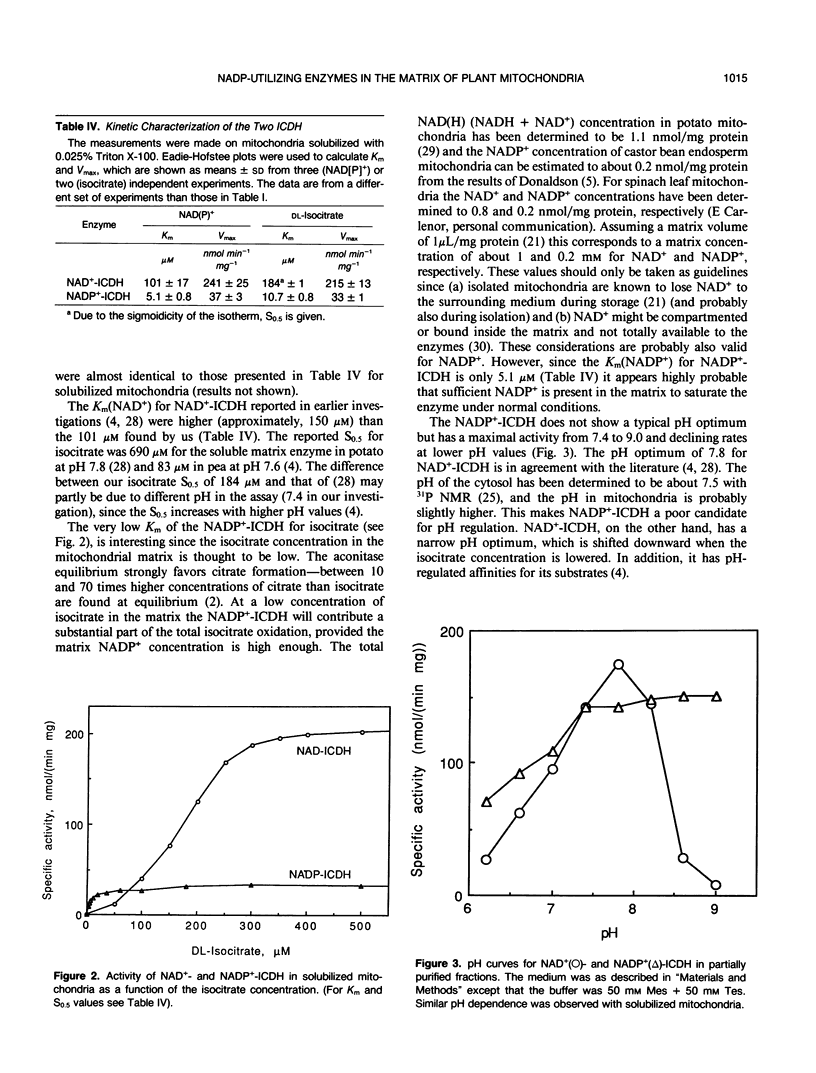Abstract
Purified potato tuber (Solanum tuberosum L. cv Bintie) mitochondria contain soluble, highly latent NAD+- and NADP+-isocitrate dehydrogenases, NAD+- and NADP+-malate dehydrogenases, as well as an NADPH-specific glutathione reductase (160, 25, 7200, 160, and 16 nanomoles NAD(P)H per minute and milligram protein, respectively). The two isocitrate dehydrogenase activities, but not the two malate dehydrogenase activities, could be separated by ammonium sulfate precipitation. Thus, the NADP+-isocitrate dehydrogenase activity is due to a separate matrix enzyme, whereas the NADP+-malate dehydrogenase activity is probably due to unspecificity of the NAD+-malate dehydrogenase. NADP+-specific isocitrate dehydrogenase had much lower Kms for NADP+ and isocitrate (5.1 and 10.7 micromolar, respectively) than the NAD+-specific enzyme (101 micromolar for NAD+ and 184 micromolar for isocitrate). A broad activity optimum at pH 7.4 to 9.0 was found for the NADP+-specific isocitrate dehydrogenase whereas the NAD+-specific enzyme had a sharp optimum at pH 7.8. Externally added NADP+ stimulated both isocitrate and malate oxidation by intact mitochondria under conditions where external NADPH oxidation was inhibited. This shows that (a) NADP+ is taken up by the mitochondria across the inner membrane and into the matrix, and (b) NADP+-reducing activities of malate dehydrogenase and the NADP+-specific isocitrate dehydrogenase in the matrix can contribute to electron transport in intact plant mitochondria. The physiological relevance of mitochondrial NADP(H) and soluble NADP(H)-consuming enzymes is discussed in relation to other known mitochondrial NADP(H)-utilizing enzymes.
Full text
PDF






Selected References
These references are in PubMed. This may not be the complete list of references from this article.
- Blair J. M. Magnesium and the aconitase equilibrium: determination of apparent stability constants of mangnesium substrate complexes from equilibrium data. Eur J Biochem. 1969 Mar;8(2):287–291. doi: 10.1111/j.1432-1033.1969.tb00526.x. [DOI] [PubMed] [Google Scholar]
- Carlenor E., Persson B., Glaser E., Andersson B., Rydström J. On the presence of a nicotinamide nucleotide transhydrogenase in mitochondria from potato tuber. Plant Physiol. 1988 Oct;88(2):303–308. doi: 10.1104/pp.88.2.303. [DOI] [PMC free article] [PubMed] [Google Scholar]
- Cox G. F., Davies D. D. The effect of pH on the characteristics of the binding of nicotinamide-adenine dinucleotide by nicotinamide-adenine dinucleotide-specific isocitrate dehydrogenase from pea mitochondria. Biochem J. 1970 Mar;116(5):819–824. doi: 10.1042/bj1160819. [DOI] [PMC free article] [PubMed] [Google Scholar]
- Donaldson R. P. Nicotinamide cofactors (NAD and NADP) in glyoxysomes, mitochondria, and plastids isolated from castor bean endosperm. Arch Biochem Biophys. 1982 Apr 15;215(1):274–279. doi: 10.1016/0003-9861(82)90305-8. [DOI] [PubMed] [Google Scholar]
- Elias B. A., Givan C. V. Alpha-ketoglutarate supply for amino Acid synthesis in higher plant chloroplasts: intrachloroplastic localization of NADP-specific isocitrate dehydrogenase. Plant Physiol. 1977 Apr;59(4):738–740. doi: 10.1104/pp.59.4.738. [DOI] [PMC free article] [PubMed] [Google Scholar]
- Hatefi Y., Hanstein W. G. Interactions of reduced and oxidized triphosphopyridine nucleotides with the electron-transport system of bovine heart mitochondria. Biochemistry. 1973 Aug 28;12(18):3515–3522. doi: 10.1021/bi00742a026. [DOI] [PubMed] [Google Scholar]
- Hoek J. B., Rydström J. Physiological roles of nicotinamide nucleotide transhydrogenase. Biochem J. 1988 Aug 15;254(1):1–10. doi: 10.1042/bj2540001. [DOI] [PMC free article] [PubMed] [Google Scholar]
- LOWRY O. H., ROSEBROUGH N. J., FARR A. L., RANDALL R. J. Protein measurement with the Folin phenol reagent. J Biol Chem. 1951 Nov;193(1):265–275. [PubMed] [Google Scholar]
- Laties G. G. Membrane-Associated NAD-Dependent Isocitrate Dehydrogenase in Potato Mitochondria. Plant Physiol. 1983 Aug;72(4):953–958. doi: 10.1104/pp.72.4.953. [DOI] [PMC free article] [PubMed] [Google Scholar]
- Neuburger M., Douce R. Slow passive diffusion of NAD+ between intact isolated plant mitochondria and suspending medium. Biochem J. 1983 Nov 15;216(2):443–450. doi: 10.1042/bj2160443. [DOI] [PMC free article] [PubMed] [Google Scholar]
- Neuburger M., Journet E. P., Bligny R., Carde J. P., Douce R. Purification of plant mitochondria by isopycnic centrifugation in density gradients of Percoll. Arch Biochem Biophys. 1982 Aug;217(1):312–323. doi: 10.1016/0003-9861(82)90507-0. [DOI] [PubMed] [Google Scholar]
- Rebeille F., Bligny R., Douce R. Is the cytosolic pi concentration a limiting factor for plant cell respiration? Plant Physiol. 1984 Feb;74(2):355–359. doi: 10.1104/pp.74.2.355. [DOI] [PMC free article] [PubMed] [Google Scholar]
- Smith C. M., Plaut G. W. Activities of NAD-specific and NADP-specific isocitrate dehydrogenases in rat-liver mitochondria. Studies with D-threo-alpha-methylisocitrate. Eur J Biochem. 1979 Jun;97(1):283–295. doi: 10.1111/j.1432-1033.1979.tb13113.x. [DOI] [PubMed] [Google Scholar]
- Tezuka T., Laties G. G. Isolation and Characterization of Inner Membrane-Associated and Matrix NAD-Specific Isocitrate Dehydrogenase in Potato Mitochondria. Plant Physiol. 1983 Aug;72(4):959–963. doi: 10.1104/pp.72.4.959. [DOI] [PMC free article] [PubMed] [Google Scholar]
- Tobin A., Djerdjour B., Journet E., Neuburger M., Douce R. Effect of NAD on Malate Oxidation in Intact Plant Mitochondria. Plant Physiol. 1980 Aug;66(2):225–229. doi: 10.1104/pp.66.2.225. [DOI] [PMC free article] [PubMed] [Google Scholar]
- von Jagow G., Klingenberg M. Pathways of hydrogen in mitochondria of Saccharomyces carlsbergensis. Eur J Biochem. 1970 Feb;12(3):583–592. doi: 10.1111/j.1432-1033.1970.tb00890.x. [DOI] [PubMed] [Google Scholar]


